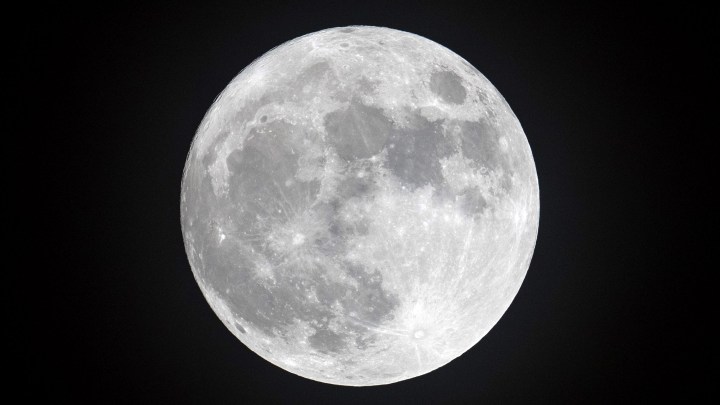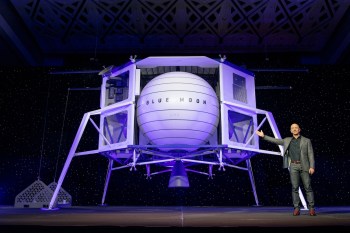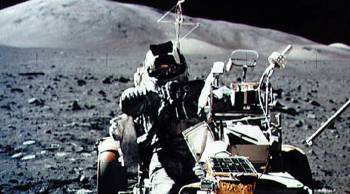
A new moon race is underway

Successful trips to the moon have historically been the domain of governments around the world. Now, private companies are competing to make successful lunar landings.
That’s because a whole bunch of entities, from universities to research organizations, want to bring stuff to the moon. And now there is a commercial market developing for providing that service, according to Tom Standage, deputy editor at The Economist and author of the recent piece “Which firm will win the new Moon race?”
“The idea is that we’re starting to move to more of a sort of marketplace in lunar landing services,” Standage said in an interview with Sabri Ben-Achour about the competition between companies to land on the moon.
The following is an edited transcript of the conversation.
Sabri Ben-Achour: So who are these companies trying to land on the moon this year? And why are they doing it?
Tom Standage: There’s three of them that have a shot at getting something onto the moon in the next few months. One of them is a Japanese company called ispace. And its mission called Hakuto-R is actually already on its way, launched in December. But it’s taking a rather roundabout way of getting to the moon, if you can believe it, so it’s not going to land until probably the end of April. And then there are two American companies called Intuitive Machines, and Astrobotic, and they are both hoping to launch in the next few months. So they were both aiming for kind of March, April launches, which meant they could have got there before Hakuto. We now know that Intuitive Machines’ launch is going to be delayed until June. So it’s definitely not going to be first. But that means the race is still on, because the Astrobotic mission is due to launch sometime in March or April. And it’s going to take a direct route to the moon. So that means it could get there before Hakuto-R despite having set out later. So the race is on.
Ben-Achour: Getting to the moon requires money. Is it all financed by investors? What’s the market incentive to go there?
Standage: So the American ones, it’s probably easier to explain: They are funded under a NASA program called CLPS, which stands for Commercial Lunar Payload Services. But essentially what NASA has been doing in a range of areas in recent years, it’s instead of building everything itself and doing everything itself, it’s gone to the private sector and said, “Look, we’d like to send stuff to the space station.” So they have a competitive contractor, people bid for that. So in the case of the space station, you know, sending astronauts up there, that’s now done by SpaceX, Elon Musk’s company.
And similarly, with sending stuff to the moon, clearly NASA wants to send astronauts to the moon in the next few years. But first, it needs to kind of scout out landing areas and all this kind of stuff. So rather than building a whole load of its own probes, its own landers, it is essentially saying, “We would like to send stuff to the moon. Who would build a lander?” And then whoever builds the lander buys a launch service from a company like SpaceX or someone else, there’s an open market in that. So essentially, there is this sort of buyer slot on a machine, and so NASA has ceded the market for these two American landers by saying, “We will buy this many slots, this much payload mass on your landers.” They then put together this whole mission where they build the lander with the money they’ve taken from NASA, but they also take money from other people who want to send stuff to the moon. So that’s private companies, it’s research organizations, it’s universities — there’s all sorts of people who want to send stuff to the moon. And they then put together this mission. So the idea is that we’re starting to move to more of a sort of marketplace in lunar landing services.
The Japanese mission is slightly different. That is entirely funded by private investors and it does have a rover on it that’s from the space agency of the UAE. But, mostly it’s Japanese companies that have paid because they want to send stuff to the moon for sort of publicity reasons.
Ben-Achour: So these companies are basically taking stuff to the moon, that’s how they’re making money or hope to make money. How far away are we do you think from extracting economic value from the moon? You know, mining, for example?
Standage: Yeah, well, that’s the thing, because you can see why there’s a commercial market in sending stuff into orbit. So in 2022, we had 178 successful launches to orbit, 90 of them were by private companies. And of those, actually, two-thirds of those were by SpaceX. So there’s clearly a commercial market in sending stuff into orbit. And that’s because there’s lots of things you can do in orbit that actually make sense. You can put up satellites to do things like broadcast radio, and TV, or internet like SpaceX does with with Starlink. There’s useful things you could do in orbit that you can make money from.
It’s not at all clear what you can make money from by sending stuff to the moon. Because legally, even if there was like piles of gold lying around on the moon, it’s not clear what the legal situation is with bringing resources back, or even using resources in situ. So it’s a slightly odd situation, because, in theory, there could be a commercial market in the future for things like tourism. But we still have this big gray area, because the Outer Space Treaty of 1967, which is what currently sort of sets the rules is clearly way out of date.
Ben-Achour: Right, there is this thing called the Outer Space Treaty of 1967. Basically it says no country can claim sovereignty over the moon. But what about companies, or companies backed by governments?
Standage: We don’t really know. And so America is trying to sort of update this and has the Artemis Accords, which is an attempt to update things so that you can start to exploit resources. But the trouble is that the Artemis Accords have been rejected by China and Russia. And then there’s a rival thing that was set up in the 1980s by a whole load of other countries, but America refused to sign that one.
So that’s the challenge, that there isn’t a sort of prevailing legal theory. And it could turn into a free-for-all, and it could, in particular, turn into a free-for-all as rival companies start saying, “Well, we’re going to send stuff into the dark parts of the south pole of the moon where there might be water,” for example, because that could potentially be quite valuable. You could use it to make fuel and stuff like that. So you can imagine there being sort of tussles between companies as well as between countries over this.
Ben-Achour: In the old days, you know, the space race was associated with a lot of secondary technology, technological progress the governments developed and shared. Do we get that today from private companies landing rovers on the moon?
Standage: Well, actually, this time around the reverse flow is happening. This is what Marc Andreessen, the venture capitalist, has called the “reverse polarity of technology flow.” Because the reason it’s much cheaper to send stuff into space and to send stuff to the moon, and the fact that you can send these much smaller rovers and things that are on these spacecraft, is that we have things like smartphone technology, which has massively reduced the cost of building complicated micro-electronic things.
Technologies used to be big, expensive things like computers, only governments could afford them first, and they would use them for military applications. GPS was originally a military technology. And they would gradually, much later, flow down to consumers. That was the old model. What’s happened since the 1990s is that video game consoles and smartphones are now the most powerful computers in people’s homes. They’re probably much more powerful than the computers they have sitting on their desks to do work with. And, actually, that’s where the action is, because those are very, very big consumer markets. And then the military and governments and space and so on benefit from the progress made in consumer electronics, which makes things cheaper, and so forth. So it’s a very interesting shift from the way things were last time there was a space race.
There’s a lot happening in the world. Through it all, Marketplace is here for you.
You rely on Marketplace to break down the world’s events and tell you how it affects you in a fact-based, approachable way. We rely on your financial support to keep making that possible.
Your donation today powers the independent journalism that you rely on. For just $5/month, you can help sustain Marketplace so we can keep reporting on the things that matter to you.

















